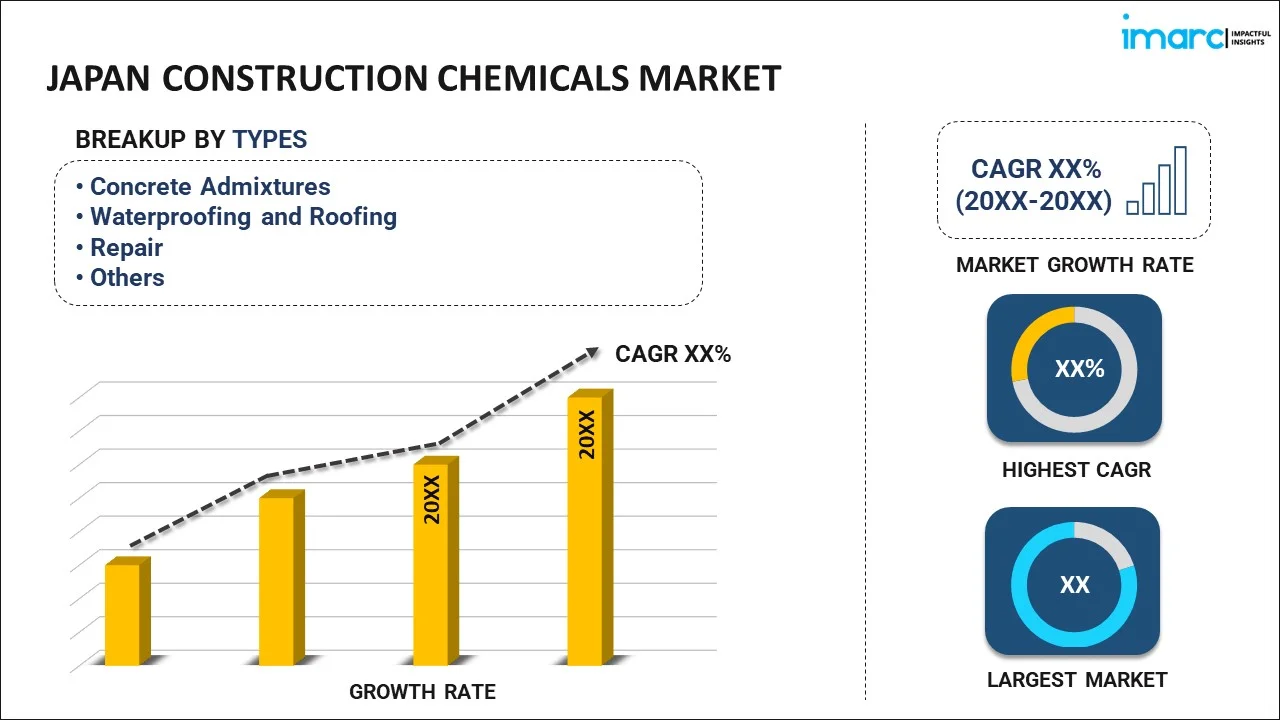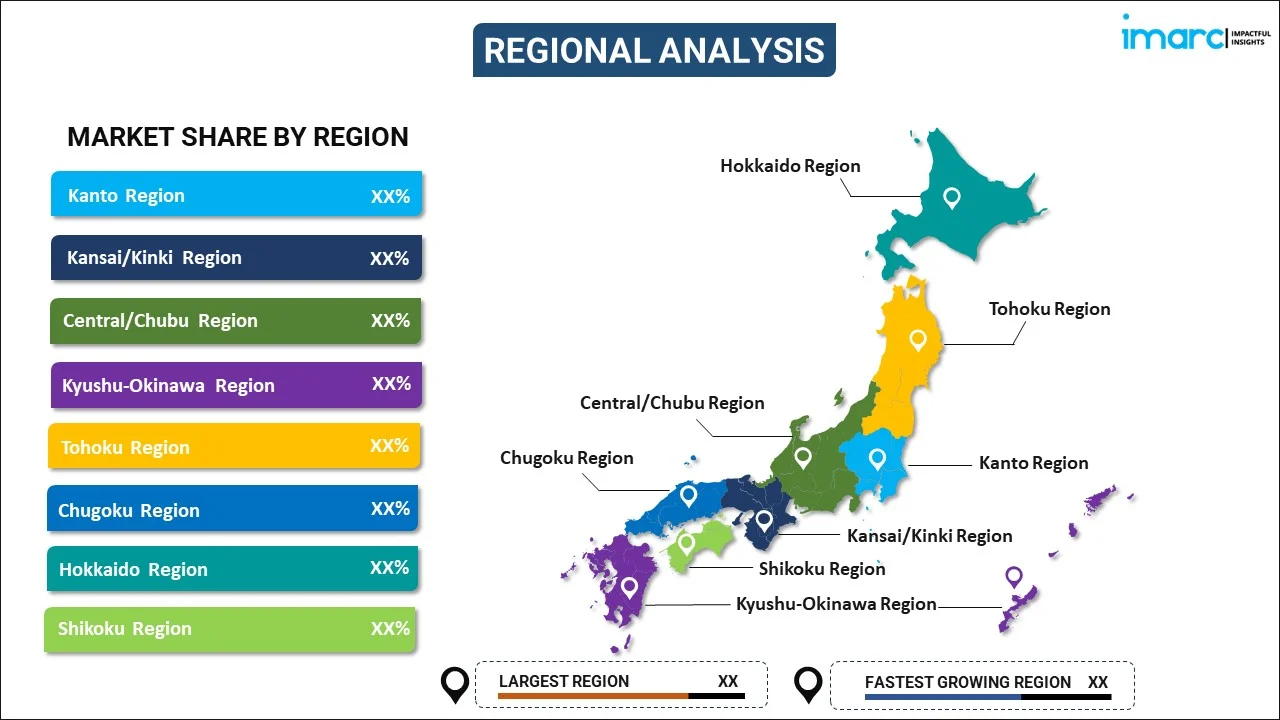
Japan Construction Chemicals Market Report by Type (Concrete Admixtures, Waterproofing and Roofing, Repair, Flooring, Sealants and Adhesives, and Others), Application (Residential, Non-Residential), and Region 2025-2033
Market Overview:
The Japan construction chemicals market size reached USD 2.6 Billion in 2024. Looking forward, IMARC Group expects the market to reach USD 3.4 Billion by 2033, exhibiting a growth rate (CAGR) of 3.07% during 2025-2033. The increasing adoption of environmentally friendly and sustainable construction practices, the rising need for durable materials due to the country’s heightened susceptibility to natural disasters, and ongoing technological advancements represent some of the key factors driving the market.
|
Report Attribute
|
Key Statistics
|
|---|---|
|
Base Year
|
2024
|
|
Forecast Years
|
2025-2033
|
|
Historical Years
|
2019-2024
|
| Market Size in 2024 | USD 2.6 Billion |
| Market Forecast in 2033 | USD 3.4 Billion |
| Market Growth Rate 2025-2033 | 3.07% |
Construction chemicals are specialized materials used in the construction industry to enhance the durability, workability, and strength of construction projects. These chemicals play a crucial role in modern construction practices, offering multiple benefits such as improved adhesion, waterproofing, and resistance to environmental and chemical stresses. Some of the most commonly used construction chemicals include concrete admixtures, waterproofing chemicals, adhesives and sealants, protective coatings, and grouts. Concrete admixtures, for instance, are added to concrete to modify its properties, improving its workability, setting time, and durability. Waterproofing chemicals are utilized to protect structures from water ingress, which can cause significant damage over time. Adhesives and sealants are essential for bonding various construction materials and providing airtight and watertight seals. Protective coatings are applied to surfaces to guard against wear, corrosion, and other environmental factors. Grouts are employed to fill gaps and reinforce structures. The use of construction chemicals facilitates the construction of longer-lasting and more resilient buildings and infrastructure. As construction techniques evolve and environmental considerations become increasingly important, the role of these chemicals in ensuring sustainability, efficiency, and safety in construction projects continues to grow. As a result, construction chemicals are gaining immense traction in modern construction owing to elevating levels of urbanization and the growing need for infrastructure development across Japan.
Japan Construction Chemicals Market Trends:
The Japan construction chemicals market is being driven by several key factors, reflecting the country’s unique economic, environmental, and technological landscape. Japan’s focus on sustainable and environmentally friendly construction practices represents one of the primary factors driving the market growth. Moreover, there is an increasing demand for green construction chemicals that are less harmful to the environment, aligning with global sustainability trends and local regulatory requirements. Along with this, the rising need for high-quality and durable construction materials due to the country’s susceptibility to natural disasters like earthquakes and typhoons is contributing to the market growth. Consequently, construction chemicals that enhance the strength, durability, and resilience of buildings are in high demand. This need for durability also extends to the maintenance and renovation of existing infrastructure, further stimulating market growth. Additionally, ongoing technological advancements in construction chemicals, such as the introduction of smart and multifunctional materials, are positively influencing market growth. Japanese companies are at the forefront of developing innovative solutions that offer improved performance and application ease, thereby attracting significant investment and research in this sector. In line with this, rapid urbanization and the subsequent increase in construction activities further propel the market growth. As urban areas expand and modernize, there is a heightened need for construction chemicals in residential, commercial, and infrastructure projects. Furthermore, the Japanese government’s extensive investments in infrastructure development, particularly in preparation for international events and to counteract the aging of existing infrastructure, is another major growth-inducing factor. This investment catalyzes the demand for a range of construction chemicals. Besides this, the strong presence of both global and local players across the country fosters innovation and the development of customized solutions suited to Japan’s specific construction challenges, thus fueling market growth.
Japan Construction Chemicals Market Segmentation:
IMARC Group provides an analysis of the key trends in each segment of the market, along with forecasts at the country level for 2025-2033. Our report has categorized the market based on type and application.
Type Insights:

- Concrete Admixtures
- Waterproofing and Roofing
- Repair
- Flooring
- Sealants and Adhesives
- Others
The report has provided a detailed breakup and analysis of the market based on the type. This includes concrete admixtures, waterproofing and roofing, repair, flooring, sealants and adhesives, and others.
Application Insights:
- Residential
- Non-Residential
A detailed breakup and analysis of the market based on the application have also been provided in the report. This includes residential and non-residential.
Regional Insights:

- Kanto Region
- Kansai/Kinki Region
- Central/ Chubu Region
- Kyushu-Okinawa Region
- Tohoku Region
- Chugoku Region
- Hokkaido Region
- Shikoku Region
The report has also provided a comprehensive analysis of all the major regional markets, which include Kanto Region, Kansai/Kinki Region, Central/ Chubu Region, Kyushu-Okinawa Region, Tohoku Region, Chugoku Region, Hokkaido Region, and Shikoku Region.
Competitive Landscape:
The market research report has also provided a comprehensive analysis of the competitive landscape. Competitive analysis such as market structure, key player positioning, top winning strategies, competitive dashboard, and company evaluation quadrant has been covered in the report. Also, detailed profiles of all major companies have been provided.
Japan Construction Chemicals Market Report Coverage:
| Report Features | Details |
|---|---|
| Base Year of the Analysis | 2024 |
| Historical Period | 2019-2024 |
| Forecast Period | 2025-2033 |
| Units | Billion USD |
| Scope of the Report | Exploration of Historical Trends and Market Outlook, Industry Catalysts and Challenges, Segment-Wise Historical and Future Market Assessment:
|
| Types Covered | Concrete Admixtures, Waterproofing and Roofing, Repair, Flooring, Sealants and Adhesives, Others |
| Applications Covered | Residential, Non-Residential |
| Regions Covered | Kanto Region, Kansai/Kinki Region, Central/ Chubu Region, Kyushu-Okinawa Region, Tohoku Region, Chugoku Region, Hokkaido Region, Shikoku Region |
| Customization Scope | 10% Free Customization |
| Post-Sale Analyst Support | 10-12 Weeks |
| Delivery Format | PDF and Excel through Email (We can also provide the editable version of the report in PPT/Word format on special request) |
Key Questions Answered in This Report:
- How has the Japan construction chemicals market performed so far and how will it perform in the coming years?
- What has been the impact of COVID-19 on the Japan construction chemicals market?
- What is the breakup of the Japan construction chemicals market on the basis of type?
- What is the breakup of the Japan construction chemicals market on the basis of application?
- What are the various stages in the value chain of the Japan construction chemicals market?
- What are the key driving factors and challenges in the Japan construction chemicals?
- What is the structure of the Japan construction chemicals market and who are the key players?
- What is the degree of competition in the Japan construction chemicals market?
Key Benefits for Stakeholders:
- IMARC’s industry report offers a comprehensive quantitative analysis of various market segments, historical and current market trends, market forecasts, and dynamics of the Japan construction chemicals market from 2019-2033.
- The research report provides the latest information on the market drivers, challenges, and opportunities in the Japan construction chemicals market.
- Porter's five forces analysis assist stakeholders in assessing the impact of new entrants, competitive rivalry, supplier power, buyer power, and the threat of substitution. It helps stakeholders to analyze the level of competition within the Japan construction chemicals industry and its attractiveness.
- Competitive landscape allows stakeholders to understand their competitive environment and provides an insight into the current positions of key players in the market.
Need more help?
- Speak to our experienced analysts for insights on the current market scenarios.
- Include additional segments and countries to customize the report as per your requirement.
- Gain an unparalleled competitive advantage in your domain by understanding how to utilize the report and positively impacting your operations and revenue.
- For further assistance, please connect with our analysts.
 Inquire Before Buying
Inquire Before Buying
 Speak to an Analyst
Speak to an Analyst
 Request Brochure
Request Brochure
 Request Customization
Request Customization




.webp)




.webp)












